Samsung Galaxy S 5 Review
by Anand Lal Shimpi & Joshua Ho on April 8, 2014 12:00 AM EST- Posted in
- Smartphones
- Samsung
- Mobile
- Galaxy S 5
Display
As the smartphone market continues to mature, the distinguishing between smartphones becomes harder and harder as OEMs continue to converge in platform and in most other aspects. This is most evident when looking at the progression from the Galaxy S2 generation to today. Back then, the Galaxy S2 was notable because of its Exynos 4210 SoC, which was far ahead of Qualcomm’s dual core Scorpion solutions at the time, which meant non-Samsung OEMs had notably worse CPU and GPU performance. The same was also true for the original Galaxy S with its Hummingbird SoC. Today, just about every OEM ships the same SoC. The difference between 8974AB and 8974AC is effectively only an eight percent CPU bump for the AC variant.
One of the key differentiators now in the market is display. The Galaxy S 5 features a 5.1-inch 1080p Full HD Super AMOLED display, equipped with the usual set of software defined color profiles. The GS5 gets a new adaptive profile that automatically adjusts the tint of the display according to the color of the ambient light. It's a neat effect, however Samsung's Cinema mode still ends up being the most accurate.
As always, we measure color accuracy using Spectracal’s CalMAN 5 software and a custom workflow for smartphones and tablets.
The results show that the Galaxy S5 has a display that is dramatically improved from the Galaxy S4. However, the Galaxy S line doesn’t exist in a vacuum, so it’s important to also look at how it compares against the best LCDs in other phones. In this department, things aren’t quite as perfect. To start, the color gamut control is still rather poor even on Cinema mode, as effectively all of the secondary colors miss the sRGB targets for saturation sweep. Yellow, cyan secondaries and green primaries are also notably out of the sRGB gamut triangle. While recent headlines have raved about the Galaxy S5’s record-setting color accuracy, I don’t see this at all in the results. Still, against the competition in the Android space, Samsung has improved a tremendous amount while other OEMs seem to be stagnating or even regressing in color accuracy. The only Android OEM that actually beats Samsung in the color accuracy department is now Google, which is strange because they contract out their hardware to other Android OEMs.
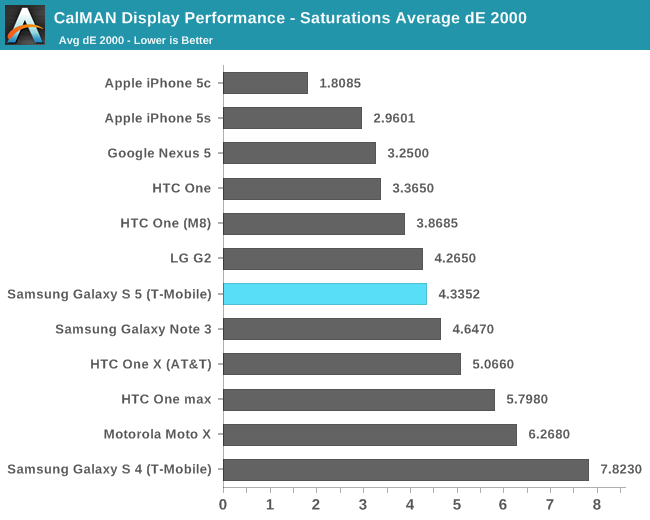
Looking at the saturation sweep, it’s evident that Samsung is now about equivalent to LG in color accuracy for their displays. HTC is barely ahead, with such a small difference that it’s not worth counting. Only Google and Apple have a noticeable lead in this department, a huge improvement from 2013 when Samsung trailed far behind most other competitors in this test.
In the Gretag Macbeth Colorchecker, Samsung continues to hold its position, beating all but Google and Apple. HTC is noticeably behind in this department compared to Samsung, as the One (M8) is horrific in this department compared to even the original HTC One.
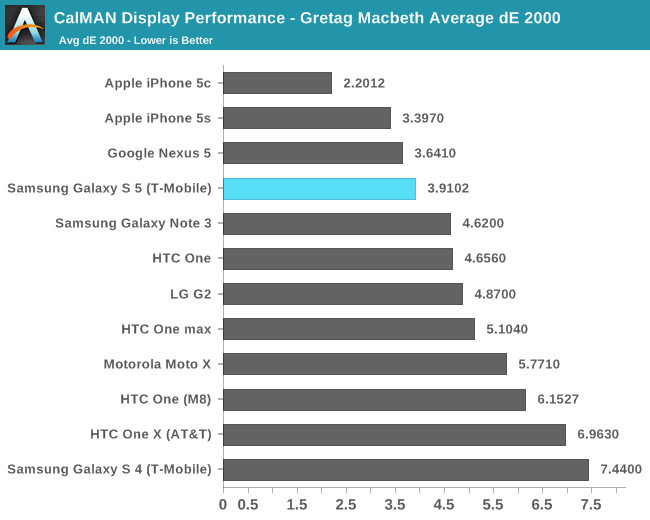
In the contrast department, Samsung continues to dominate, with effectively infinite contrast. Based upon some quick viewing of the display in the darkest room I have in the house, I don’t see any obvious DC bias issues. Unfortunately, I still see some ghosting on the display at low brightness which manifests as a purple trail when scrolling. This seems to be unchanged from the Galaxy S4. The minimum white brightness is around 1.8 nits, which is great for reading at night, as many LCD-screened phones such as the LG G Pro 2 have a minimum white brightness of around 7-12 nits.
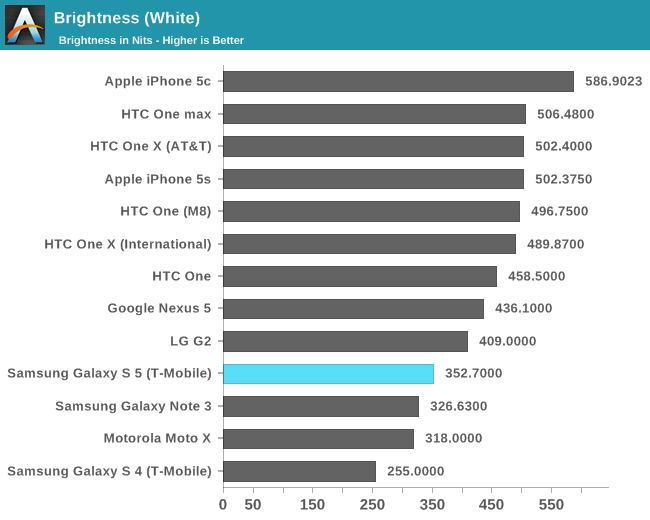
Samsung has also made great gains in the maximum brightness department, which is especially pleasing because for the longest time, AMOLED was noticeably less bright which made it incredibly difficult to read webpages and similar content outdoors. I’m happy to say that this is no longer the case, as the Galaxy S5 now has a display that realistically reaches around 440 nits outdoors with a pure white image, although this requires auto-brightness to be on and will vary with the screen mode. The maximum that is accessible without this daytime boost mode is somewhere around 350 nits.
The problem is the way Samsung has achieved this, something that is shown in the grayscale tests. While Samsung has done a great job in clamping down the white point to around 6504k, grayscale is so noticeably green that not only does CalMAN show this in the measurements, but also casual observation. I can literally see that the grayscale image is not gray, but an off-green. I’m not quite sure how this happened, but I suspect that this was done in an effort to increase peak brightness as even in the bluest display mode, green is still closely tracking with blue.
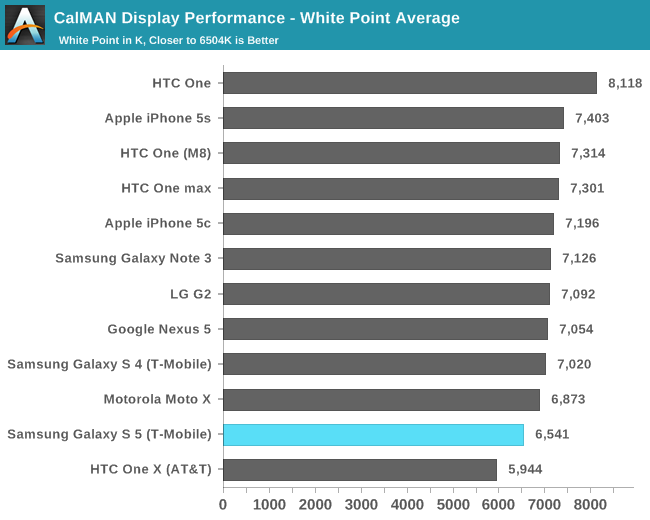
Overall, I’m quite pleased with the display. The AMOLED display in the Galaxy S5 is finally equivalent to LCD displays in color accuracy and peak luminance, areas that LCD used to be the best in. Throw in the incredible contrast that AMOLED has always had and the ability to toggle between wide color gamut and accurate color, and I would say that AMOLED is finally equal, if not slightly better than LCD. With a few more iterations, I wouldn’t be surprised if I were to write that AMOLED is clearly superior to LCD. Of course, there are some issues such as a noticeable green tint to the display in grayscale and Samsung still needs to improve their clamping of gamut to sRGB for Cinema/Movie mode, but none of these issues seriously detract from the viewing experience.


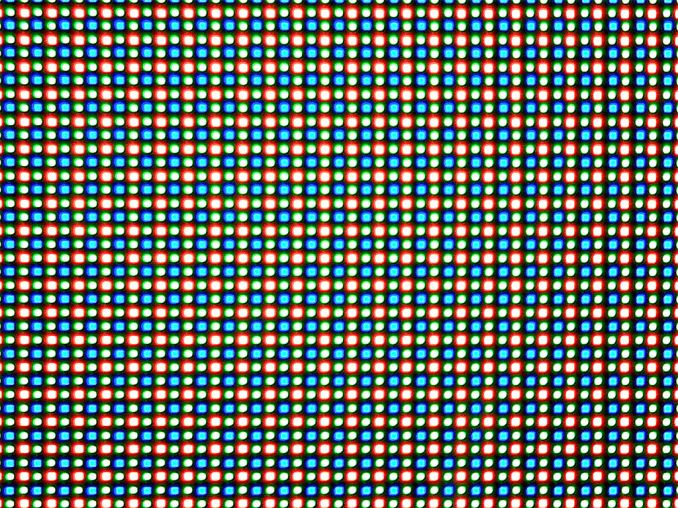












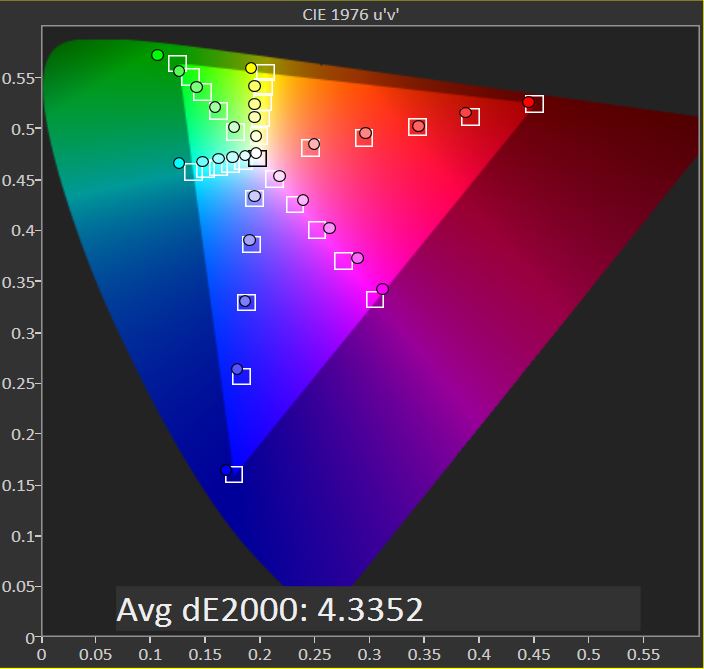
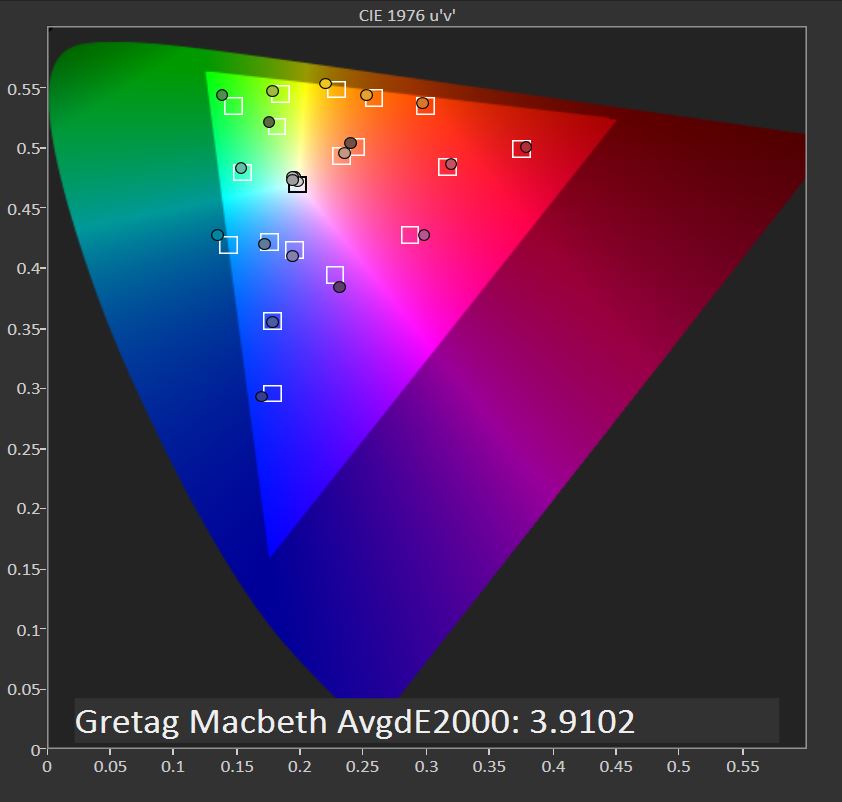









296 Comments
View All Comments
pppp6071 - Wednesday, April 9, 2014 - link
What r u talking about. I never faced any issues on My Nexus 5 regarding software or hardware. RGB is real pixel and not RG BG samsung cheap grossly over saturated colors. Nexus 5 is the best screen/ touch till date and yeah nexus 5 delivers better low light performance and with OIS better videos than Galaxy S4. And yes if being cheap is an draw back then yes Nexus 5 is Cheap. You better face reality.Serroots - Thursday, April 10, 2014 - link
I'm sorry but I truly hate the N5 screen. I've got an S4 and friends have the N5. Every time I pick it up I immediately notice how washed out the colours look. It's a great phone don't get me wrong, but I hate the screen.twebber - Tuesday, April 8, 2014 - link
Yeah I have like 74GB of storage space because of my micro sd card, lets seen your nexus do that.bleached - Tuesday, April 8, 2014 - link
I have about 150Gb of storage available on my Nexus 5 with 50Gb free.hero4hire - Thursday, April 10, 2014 - link
Cloud storage? stop. I have 100 TB of storage on my iphone 3gs because it has a web browser too...Chaser - Tuesday, April 8, 2014 - link
Nexus 5 battery life is paltry compared to the S5. And that's far beyond "basically". So no we're not all lost sheep and you're the brilliant, informed consumer.jmunjr - Tuesday, April 8, 2014 - link
The Samsungs have user replaceable batteries and external SD card slots. Those features alone make their phones MUCH better, for me at least.Until a phone can be recharged in less than 15 minutes I will continue to buy phones that have user replaceable batteries. I swap batteries several times a week. I never have to worry about charging. I never have to wait more than time it takes to shut down, swap batteries and boot up.
The SD card slot is another nicety. Though not a deal breaker if it is missing, it sure is nice to have extra storage beyond what the phone makers offer among other conveniences of transferring files to devices that aren't networked..
goobersnatcher - Thursday, April 10, 2014 - link
I agree about the removable battery. That's why I won't buy a M8 if I were interested in choosing between the S5 and M8.comomolo - Tuesday, April 8, 2014 - link
For such a rant about others idiocy, you don't seem to have very solid arguments, just a pretty subjective opinion.Lack of microSD and replaceable battery is a no go for many people (including myself) against the Nexus. Also, besides all the FUD around "tech" sites, AMOLED is just a much better technology for any screen and especially useful on mobile devices... if it was properly leveraged, which amazingly Samsung does not, but a knowledgeable user can. Even if you don't take advantage of the low consumption of dark themes on OLEDs, you get the best screen out there with the S5, according to DisplayMate.
Now why exactly is the Nexus 5 so "superior"?
goobersnatcher - Thursday, April 10, 2014 - link
The N5 isn't superior by any measure other than the promise of fast OS updates. However, when you take in the huge "bang for the buck" .......... the N5 is very compelling! The Moto X, very nice when it was on sale. You can buy a N5 and a nice tablet for the purchase price of a S5. The value for many for the $600.00+ price for a S5 ......... is prohibitive. Of course I respect those who value having one of the best ...... if that means that much! It's just "different stroke for different folks"!